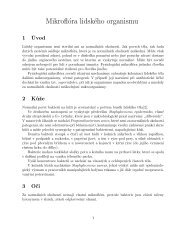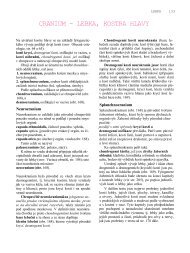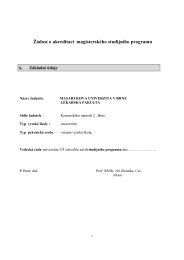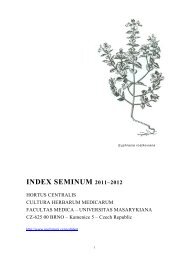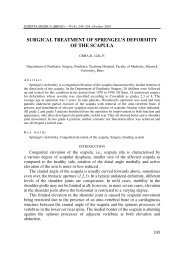Pathophysiology of GIT I
Pathophysiology of GIT I
Pathophysiology of GIT I
Create successful ePaper yourself
Turn your PDF publications into a flip-book with our unique Google optimized e-Paper software.
Cholera<br />
• Vibrio cholerae<br />
• produces toxin binding to<br />
monosialoganglioside receptor on the<br />
luminal membrane <strong>of</strong> enterocytes<br />
• activation <strong>of</strong> cAMP signaling cascade and<br />
CFTR channel<br />
• secretion <strong>of</strong> Cl and Na (and thus water) into<br />
the intest. lumen<br />
• production <strong>of</strong> up to<br />
20l <strong>of</strong> f fl fluid id daily d il<br />
• transmission by<br />
contaminated<br />
water t (rivers, ( i wells, ll<br />
lakes) and food<br />
• V. cholerae carriers<br />
• in gallbladder<br />
• ~5% population in<br />
endemic areas<br />
45<br />
Intest. motility disorders<br />
• peristaltics = coordinated contraction <strong>of</strong> muscular layers<br />
• necessary for mixing <strong>of</strong> lumen content with<br />
pancreatic juice and bile and aboral movement<br />
<strong>of</strong> digested content<br />
• regulation<br />
• peristaltics is spontaneous but intensity is<br />
regulated<br />
• hormonal (gastrin, secretin, CCK, motilin, VIP,<br />
somatostatin, enteroglukagon, opioids)<br />
• neural (vegetative nerv. nerv syst.) syst )<br />
• types <strong>of</strong> movement<br />
• fasting state<br />
• spontaneous contractions<br />
• migrating myoelectric complex (MMC) ~1x/1.5 hr.<br />
• after fte meals me l<br />
• segmentations ~ 10x/min<br />
• peristalsis<br />
• reflexes<br />
• intestino-intestinal<br />
• gastro-intestinall<br />
• ileogastric<br />
• trauma <strong>of</strong> other organs (e.g. gonads, kidneys, ..) lead to reflex. stop <strong>of</strong> peristaltics (sympathetic<br />
n.s.) → atonic (paralytic ileus)<br />
• disorders<br />
• hypomotility (extreme form = ileus)<br />
• hypermotility<br />
• drugs affecting intest. motility<br />
• purposefully – laxatives (secretory, osmotic, emolients, fiber) x prokinetics<br />
• side effects – opiates opiates, sympatomimetics, sympatomimetics anticholinergics, anticholinergics …<br />
47<br />
Action <strong>of</strong> V. cholerae toxin<br />
46<br />
Ileus<br />
• block <strong>of</strong> intestinal passage<br />
• mechanic = due to the external or<br />
internal obstruction<br />
• intraluminal: obstruction by tumor (e), bile stones (f),<br />
strictures, inflammation<br />
• extraluminal: adhesions, compression, herniation (a),<br />
invagination (b), strangulation (c), volvulus (d)<br />
• paralytic p y or o spastic sp s = ↓ motility o y<br />
• postoperative<br />
• acute pancreatitis<br />
• pain (colic, trauma, myocardial infarction)<br />
• peritonitis<br />
• hypokalemia<br />
• at first peristaltics increased as an<br />
attempt to overcome the block<br />
• water water, gases and content stagnate<br />
above the block<br />
• distension <strong>of</strong> intestine, hypoperfusion<br />
and later necrosis <strong>of</strong> the wall<br />
• if not quickly surgically solved then<br />
lethal – dehydration, ion dysbalance and<br />
toxemia (bacteria from lumen into<br />
circulation)<br />
48



